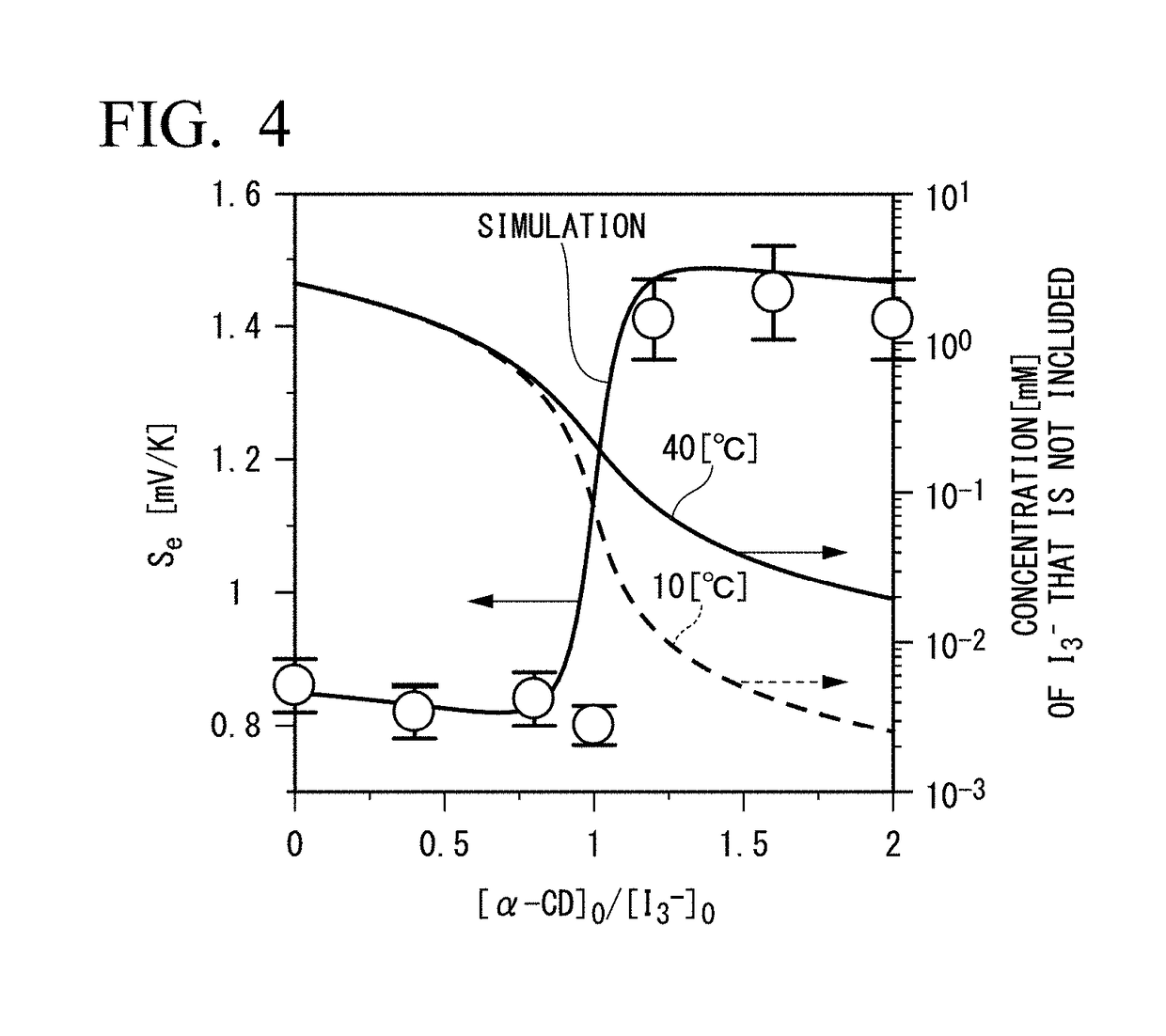Thermoelectric conversion material, thermoelectric conversion device having the same, thermo-electrochemical cell and thermoelectric sensor
a technology of thermoelectric conversion material and thermoelectric sensor, which is applied in the manufacture/treatment of thermoelectric devices, instruments, batteries, etc., can solve the problems of low conductivity of electrolyte, high thermal conductivity of conventional alloy-based thermoelectric conversion material, and low seebeck coefficient (se). the effect of improving the seebeck coefficien
- Summary
- Abstract
- Description
- Claims
- Application Information
AI Technical Summary
Benefits of technology
Problems solved by technology
Method used
Image
Examples
example 1
[0128]
[0129]I2 (317 mg, 1.25 mmol), KI (415 mg, 2.50 mmol) and water were added to an H-type container having two tubes as shown in FIG. 10, and a solution having [KI] 50 mM and [KI3 ] 50 mM were prepared. To 2.5 ml of the solution, 0.2 mmol of α-CD (25 mM) was added, followed by dilution with a KI aqueous solution to obtain [KI3] 2.5 mM, [KI] 10 mM, and [α-CD] 4 mM. The first test tube of the two H type test tubes was set in an ice bath and the temperature in the vicinity of the first electrode was held at 10° C. The second test tube was set in a thermostat capable of adjusting at 10 to 50° C., and the temperature in the vicinity of the second electrode was adjusted to 10 to 50° C.
[0130]
[0131]Platinum wires were inserted to each of the first tube and the second tube containing an aqueous solution having [KI3] 2.5 mM, [KI] 10 mM, and [α-CD] 4 mM.
[0132]3−>
[0133]A Seebeck coefficient was determined from a slope of a straight line shown in FIG. 11. The Seebeck coefficients were increas...
example 2
[0134]Example 2 is the same as that of Example 1, except for addition of HCl (0.1 M). FIG. 12 is a diagram showing a Seebeck coefficient (solid line) [mV / K] after addition of HCl. As the same as that in Example 1, from FIG. 12, the Seebeck Coefficient (Se) is increased from 0.56 mV / K without addition of α-CD to 1.16 after the addition of the same. FIG. 12 also shows comparison with Example 1. The activity of I3− / I− was changed by adding HCl. Se was decreased from 1.43 mV / K to 1.16 mV / K with addition of α-CD, and it decreased from 0.86 mV / K to 0.56 mV / K without addition of α-CD.
[0135]
[0136]Increase of both an open-circuit voltage (Voc) and an output power density by adding α-CD was observed.
[0137]FIG. 13 is a diagram showing increase of power density (electrolyte: HCl) due to I3− inclusion.
[0138]
[0139]FIG. 14 is a diagram in which the temporal change in the power density of a cell to which α-CD and an electrolyte (: HCl) were added was recorded.
example 3
[0140]Example 3 is the same as that of Example 1, except for the addition of KCl (0.2 M). FIG. 15 shows the Seebeck coefficient (solid line, mV / K) after addition of KCl. As in Example 1, in FIG. 15, the Seebeck coefficient (Se) increased from 0.86 mV / K without α-CD to 1.96 mV / K after addition of α-CD. FIG. 15 also shows a comparison with Example 1. Addition of KCl did not change the activity of I3− / I−. When α-CD was added, Se increased from 1.43 mV / K to 1.96 mV / K, and when α-CD was not added, Se was 0.86 mV / K without change.
[0141]In Example 3, unlike Examples 1 and 2, a dark green precipitate K[(α-CD)2−I5] was observed. It is considered that Seebeck coefficient increases because of the formation of precipitates.
[0142]2−I5]>
[0143]In order to identify the dark green precipitate, a following aqueous solution was prepared and a structure of the precipitate was evaluated. The concentrations of each ion in the aqueous solution is shown below.
[0144][I3−]0=[I−]0=8 mM,
[0145][α-CD]0=4 mM
[0146...
PUM
 Login to View More
Login to View More Abstract
Description
Claims
Application Information
 Login to View More
Login to View More - R&D
- Intellectual Property
- Life Sciences
- Materials
- Tech Scout
- Unparalleled Data Quality
- Higher Quality Content
- 60% Fewer Hallucinations
Browse by: Latest US Patents, China's latest patents, Technical Efficacy Thesaurus, Application Domain, Technology Topic, Popular Technical Reports.
© 2025 PatSnap. All rights reserved.Legal|Privacy policy|Modern Slavery Act Transparency Statement|Sitemap|About US| Contact US: help@patsnap.com



